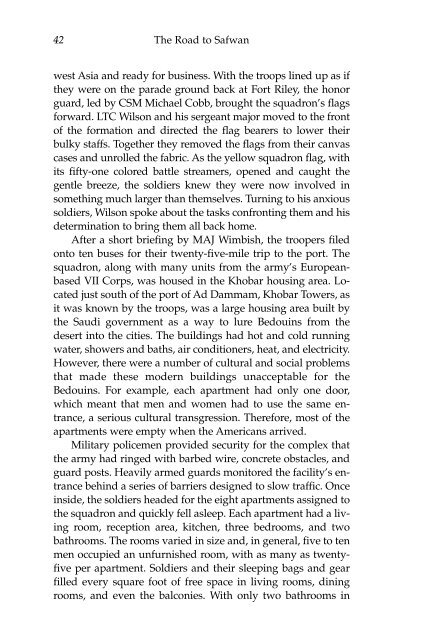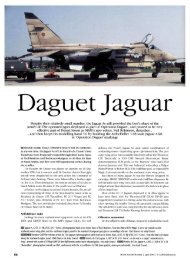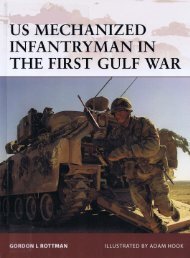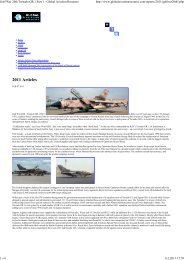The Road to Safwan: The 1st Squadron, 4th Cavalry in the 1991 ...
The Road to Safwan: The 1st Squadron, 4th Cavalry in the 1991 ...
The Road to Safwan: The 1st Squadron, 4th Cavalry in the 1991 ...
Create successful ePaper yourself
Turn your PDF publications into a flip-book with our unique Google optimized e-Paper software.
42 <strong>The</strong> <strong>Road</strong> <strong>to</strong> <strong>Safwan</strong><br />
west Asia and ready for bus<strong>in</strong>ess. With <strong>the</strong> troops l<strong>in</strong>ed up as if<br />
<strong>the</strong>y were on <strong>the</strong> parade ground back at Fort Riley, <strong>the</strong> honor<br />
guard, led by CSM Michael Cobb, brought <strong>the</strong> squadron’s flags<br />
forward. LTC Wilson and his sergeant major moved <strong>to</strong> <strong>the</strong> front<br />
of <strong>the</strong> formation and directed <strong>the</strong> flag bearers <strong>to</strong> lower <strong>the</strong>ir<br />
bulky staffs. Toge<strong>the</strong>r <strong>the</strong>y removed <strong>the</strong> flags from <strong>the</strong>ir canvas<br />
cases and unrolled <strong>the</strong> fabric. As <strong>the</strong> yellow squadron flag, with<br />
its fifty-one colored battle streamers, opened and caught <strong>the</strong><br />
gentle breeze, <strong>the</strong> soldiers knew <strong>the</strong>y were now <strong>in</strong>volved <strong>in</strong><br />
someth<strong>in</strong>g much larger than <strong>the</strong>mselves. Turn<strong>in</strong>g <strong>to</strong> his anxious<br />
soldiers, Wilson spoke about <strong>the</strong> tasks confront<strong>in</strong>g <strong>the</strong>m and his<br />
determ<strong>in</strong>ation <strong>to</strong> br<strong>in</strong>g <strong>the</strong>m all back home.<br />
After a short brief<strong>in</strong>g by MAJ Wimbish, <strong>the</strong> troopers filed<br />
on<strong>to</strong> ten buses for <strong>the</strong>ir twenty-five-mile trip <strong>to</strong> <strong>the</strong> port. <strong>The</strong><br />
squadron, along with many units from <strong>the</strong> army’s Europeanbased<br />
VII Corps, was housed <strong>in</strong> <strong>the</strong> Khobar hous<strong>in</strong>g area. Located<br />
just south of <strong>the</strong> port of Ad Dammam, Khobar Towers, as<br />
it was known by <strong>the</strong> troops, was a large hous<strong>in</strong>g area built by<br />
<strong>the</strong> Saudi government as a way <strong>to</strong> lure Bedou<strong>in</strong>s from <strong>the</strong><br />
desert <strong>in</strong><strong>to</strong> <strong>the</strong> cities. <strong>The</strong> build<strong>in</strong>gs had hot and cold runn<strong>in</strong>g<br />
water, showers and baths, air conditioners, heat, and electricity.<br />
However, <strong>the</strong>re were a number of cultural and social problems<br />
that made <strong>the</strong>se modern build<strong>in</strong>gs unacceptable for <strong>the</strong><br />
Bedou<strong>in</strong>s. For example, each apartment had only one door,<br />
which meant that men and women had <strong>to</strong> use <strong>the</strong> same entrance,<br />
a serious cultural transgression. <strong>The</strong>refore, most of <strong>the</strong><br />
apartments were empty when <strong>the</strong> Americans arrived.<br />
Military policemen provided security for <strong>the</strong> complex that<br />
<strong>the</strong> army had r<strong>in</strong>ged with barbed wire, concrete obstacles, and<br />
guard posts. Heavily armed guards moni<strong>to</strong>red <strong>the</strong> facility’s entrance<br />
beh<strong>in</strong>d a series of barriers designed <strong>to</strong> slow traffic. Once<br />
<strong>in</strong>side, <strong>the</strong> soldiers headed for <strong>the</strong> eight apartments assigned <strong>to</strong><br />
<strong>the</strong> squadron and quickly fell asleep. Each apartment had a liv<strong>in</strong>g<br />
room, reception area, kitchen, three bedrooms, and two<br />
bathrooms. <strong>The</strong> rooms varied <strong>in</strong> size and, <strong>in</strong> general, five <strong>to</strong> ten<br />
men occupied an unfurnished room, with as many as twentyfive<br />
per apartment. Soldiers and <strong>the</strong>ir sleep<strong>in</strong>g bags and gear<br />
filled every square foot of free space <strong>in</strong> liv<strong>in</strong>g rooms, d<strong>in</strong><strong>in</strong>g<br />
rooms, and even <strong>the</strong> balconies. With only two bathrooms <strong>in</strong>
















